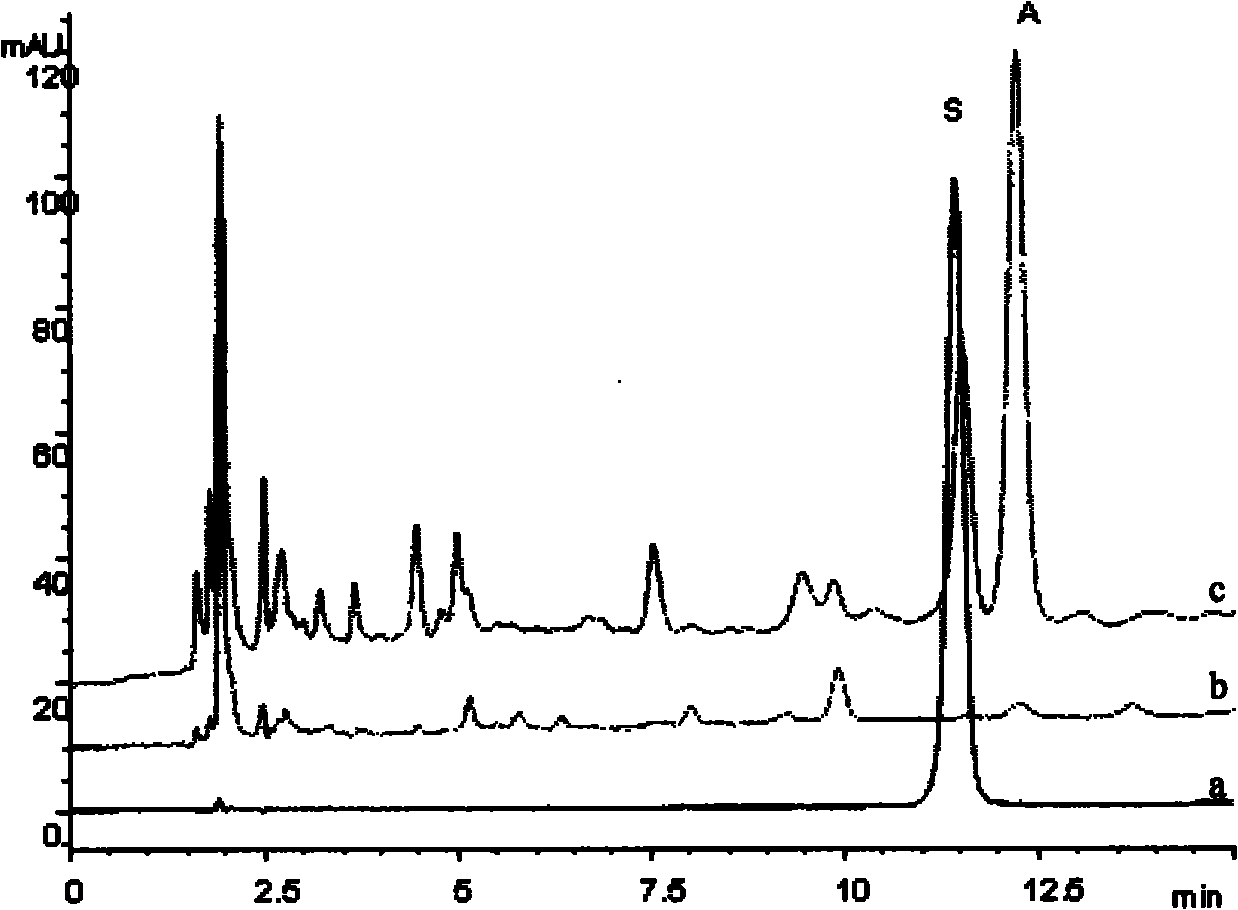Method for distinguishing bee glue and poplar glue
A technology of propolis and poplar, applied in the direction of measuring devices, instruments, scientific instruments, etc., to achieve high sensitivity, strong feasibility, and good separation effect
- Summary
- Abstract
- Description
- Claims
- Application Information
AI Technical Summary
Problems solved by technology
Method used
Image
Examples
Embodiment 1
[0025] Accurately weigh 1.0 mg of salicin, and dilute to 100 ml with methanol. Pass through a 0.45 μm filter membrane and analyze by HPLC. Adopt the chromatographic column of Sepax HP-C 18 (4.6 * 150mm, 5 μ m), mobile phase is acetonitrile: 0.5% H 3 PO 4 =5:95, the flow rate was adjusted to 1.0 mL / min, the detection wavelength was 213 nm, the column temperature was 30° C., and the injection volume was 5 μL. see figure 1 a.
[0026] Take 1g of pure propolis, dissolve in methanol, filter to obtain pure propolis solution, dilute to 50ml with methanol, pass through a 0.45μm filter membrane, and analyze by HPLC. Adopt the chromatographic column of Sepax HP-C18 (4.6 * 150mm, 5 μ m), mobile phase is acetonitrile: 0.5% H 3 PO 4 =5:95, the flow rate was adjusted to 1.0 mL / min, the detection wavelength was 213 nm, the column temperature was 30° C., and the injection volume was 5 μL. see figure 1 b.
[0027] Take 1g of pure propolis mixed with 5%, 10%, 20%, 30%, and 40% poplar g...
Embodiment 2
[0031] Accurately weigh 1.0 mg of salicin, and dilute to 100 ml with methanol. Pass through a 0.45 μm filter membrane and analyze by HPLC. Adopt the chromatographic column of Sepax HP-C18 (4.6 * 150mm, 5 μ m), mobile phase is acetonitrile: 0.5% H 3 PO 4 =5:95, the flow rate was adjusted to 0.8 mL / min, the detection wavelength was 220 nm, the column temperature was 33° C., and the injection volume was 2 μL. see figure 2 .
[0032] Take 1 g of pure propolis, dissolve in methanol, filter to obtain pure propolis solution, dilute to 50 ml with methanol, pass through a 0.45 μm filter membrane, and analyze by HPLC. Adopt the chromatographic column of Sepax HP-C18 (4.6 * 150mm, 5 μ m), mobile phase is acetonitrile: 0.5% H 3 PO 4 =5:95, the flow rate was adjusted to 0.8 mL / min, the detection wavelength was 220 nm, the column temperature was 33° C., and the injection volume was 2 μL. see figure 2 .
[0033] Take 1 g of poplar gum, dissolve it in methanol, filter to obtain a p...
Embodiment 3
[0035] Accurately weigh 1.0 mg of salicin, and dilute to 100 ml with methanol. Pass through a 0.45 μm filter membrane and analyze by HPLC. Adopt the chromatographic column of Sepax HP-C18 (4.6 * 150mm, 5 μ m), mobile phase is acetonitrile: 0.5% H 3 PO 4=5:95, the flow rate was adjusted to 0.5 mL / min, the detection wavelength was 269 nm, the column temperature was 35° C., and the injection volume was 10 μL. see image 3 .
[0036] Take 1g of pure propolis, dissolve in methanol, filter to obtain pure propolis solution, dilute to 50ml with methanol, pass through a 0.45μm filter membrane, and analyze by HPLC. Adopt the chromatographic column of Sepax HP-C18 (4.6 * 150mm, 5 μ m), mobile phase is acetonitrile: 0.5% H 3 PO 4 =5:95, the flow rate was adjusted to 0.5 mL / min, the detection wavelength was 269 nm, the column temperature was 35° C., and the injection volume was 10 μL. see image 3 .
[0037] Take 1 g of poplar gum, dissolve it in methanol, filter to obtain a popla...
PUM
 Login to View More
Login to View More Abstract
Description
Claims
Application Information
 Login to View More
Login to View More - R&D
- Intellectual Property
- Life Sciences
- Materials
- Tech Scout
- Unparalleled Data Quality
- Higher Quality Content
- 60% Fewer Hallucinations
Browse by: Latest US Patents, China's latest patents, Technical Efficacy Thesaurus, Application Domain, Technology Topic, Popular Technical Reports.
© 2025 PatSnap. All rights reserved.Legal|Privacy policy|Modern Slavery Act Transparency Statement|Sitemap|About US| Contact US: help@patsnap.com



